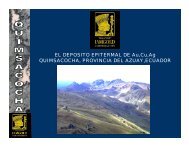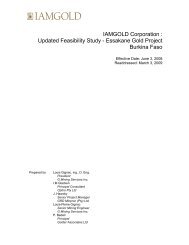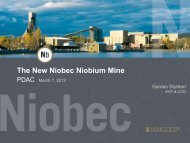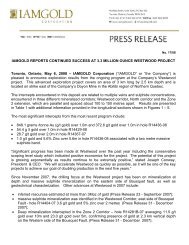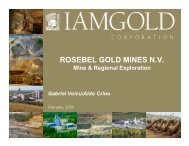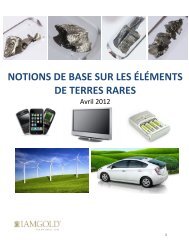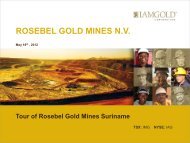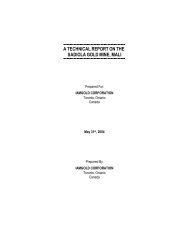NI 43-101 Technical report, Surface diamond drilling ... - Iamgold
NI 43-101 Technical report, Surface diamond drilling ... - Iamgold
NI 43-101 Technical report, Surface diamond drilling ... - Iamgold
Create successful ePaper yourself
Turn your PDF publications into a flip-book with our unique Google optimized e-Paper software.
R a r e E a r t h E l e m e n t E x p l o r a t i o n P r o g r a m M a r c h - 2 0 1 3<br />
W i n t e r - S u m m e r 2 0 1 2 P a g e | 29<br />
The REE are largely hosted by rock-forming minerals where they substitute for major ions.<br />
Higher concentrations of REE are required to form their own minerals (Miller, 1986).<br />
Around 200 minerals are known to contain REE, although a relatively small number are or<br />
may become commercially significant.<br />
The REE in carbonatites are almost entirely LREE which occur in minerals such as<br />
bastnaesite, allanite, apatite and monazite (Gupta and Krishnamurthy, 2005). REE do not<br />
occur naturally as metallic elements, they occur in a wide range of mineral types including<br />
halides, carbonates, oxides and phosphates.<br />
The vast majority of resources are associated with just three minerals, bastnaesite, monazite<br />
and xenotime. In some REE minerals, the LREE are particularly enriched relative to the<br />
HREE, which in others the opposite is the case. Bastnaesite and monazite are the primary<br />
source of the LREE, mainly Ce, La and Nd. Monazite has a different balance as it contains<br />
less La and more Nd and HREE. It is also significant to note that monazite contains the<br />
thorium, a radioactive element.<br />
Figure 7: Schematic section and plan view of a carbonatite complex (SIDEX.ca)<br />
Schematic section and plan view (mid-level) of a carbonatite complex, showing cylindrical<br />
shape of intrusion that evolves upwards into a diatreme breccia and layered tuffs. Late dikes<br />
(bold lines) display a radial or concentric pattern. The intrusion consists of three phases:<br />
sövite (calcite-rich carbonatite), iron-rich magnesian carbonatite, and ijolite (nephelinepyroxene<br />
rock). The host rocks are fenitized (alkaline metasomatism) and desilicified.<br />
3400, chemin du Columbium, St-Honoré-de-Chicoutimi, QC G0V 1L0 Canada – tel. : 418 673-4694 Fax : 418 673-3179<br />
E-mail : info.niobec@iamgold.com www.niobec.com



